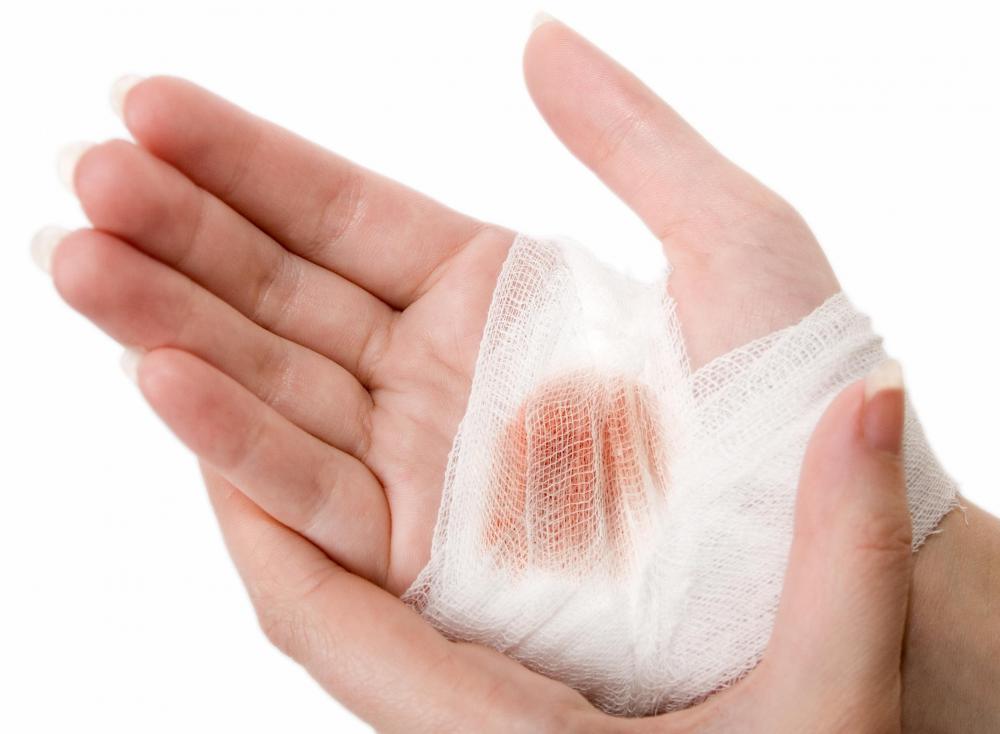At WiseGEEK, we're committed to delivering accurate, trustworthy information. Our expert-authored content is rigorously fact-checked and sourced from credible authorities. Discover how we uphold the highest standards in providing you with reliable knowledge.
What are the Most Common Wound Infection Symptoms?
Any skin injury is at risk of becoming infected. An infection can occur when bacteria from the environment gets into an open wound, such as a scratch, cut, scrape, or puncture wound. While deep cuts that are not cleaned and dressed properly are the most at risk for infection, even small scratches that have been well taken care of can become infected. Some common wound infection symptoms are swelling, redness, discharge, and pain. These symptoms, if left untreated, could lead to a more serious infection.
Swelling is one of the more common symptoms of wound infection. While some swelling around a wound area is sometimes normal, any swelling that lasts for more than three to five days can be a sign of infection. If the swelling is due to a local infection, it will go past the wound area, and it will look very red. Swelling that is caused by an infection will also typically be hot or warm to the touch.

Some redness around a wound site is often typical of a less serious infection. Red streaks that run away from the wound site towards the lymph nodes, however, can be a sign of a more serious infection. Lymphangitis is the infection of the lymph vessels, often caused by the streptococcal or staphylococcal bacteria. If this streaking is noticed as one of an individual's wound infection symptoms, prompt medical attention is strongly advised. This type of infection, if not swiftly treated, can lead to much more serious, possibly life-threatening complications, such as sepsis.

Any type of discharge from the wound site is often another common symptom that a wound has become infected. This discharge, often referred to as pus, can be cloudy, yellowish, or greenish, and it may be very foul smelling. It may seem quite unsavory, but this substance is usually a combination of dead skin cells, white blood cells, and bacteria. It is the body's way of attempting to expel the infection from the body, and it is important that it drains. Pus that becomes trapped below the surface of the skin can form an abscess, which often needs to be drained by a physician.

Pain around the wound site is another of the more common wound infection symptoms. This may feel like a tenderness or a burning pain on and around the wound site. Some pain or tenderness is expected with many types of wounds, but pain that intensifies instead of lessens as time goes by is typically a sign of infection. The pain is often accompanied by swelling, redness, and pus.
AS FEATURED ON:
AS FEATURED ON:















Discussion Comments
@dfoster85 - Yikes! That sounds really uncomfortable; glad it cleared up! My kids have both gotten yeast diaper rashes and it looks awful, but I used Lotrimin on that, too.
I also had a c-section, but I *did* have a surgical wound infection symptoms--I developed a low-grade fever. I think I just had a touch of the flu, coincidentally enough. I was still in the hospital and they put me on IV antibiotics just to be on the safe side.
And I'm glad they did--any fever after a surgery or injury could be infection and that can be serious! Don't just assume you have a virus or something. Call your doc!
Another kind of infection to be on the lookout for is a yeast skin infection. That's actually what happened to me. With a c-section and probably with other kinds of abdominal surgery especially, you can sort of have a flap that hangs down over your incision. Anywhere that you have skin-to-skin touching like that is a perfect breeding ground for yeast. If you see a rash around your surgical site, make sure to show it to your doctor! (Mine cleared up with a little over-the-counter antifungal -- Lotrimin, I think.)
Post your comments